The Jai Jui flower is a beautiful, sweetly fragrant flowering plant that is treasured for its intense yet delicate perfume. Also known as jasmine auriculatum or jasminum auriculatum, this night-blooming plant is often cultivated for its heady floral scent used in perfumes. With shiny dark green leaves and clusters of creamy white star-shaped blossoms, the Jai Jui makes a wonderful addition to gardens in warm climates. By providing the right growing conditions and proper care, you can successfully grow this captivating flower at home.
Botanical Name: Jasminum Auriculatum
Here are the names of Jai Jui Flower in Different Indian Languages:
Hindi: जय जुई (Jai Jui)
Bengali: জয় জুই (Joi Zui)
Telugu: జయ్ జుయి (Jay Juyi)
Marathi: जय जुई (Jai Jui)
Tamil: ஜை ஜுயி (Jai Juyi)
Urdu: جئی جئی (Jai Jui)
Gujarati: જય જુઈ (Jai Jui)
Malayalam: ജൈ ജുയി (Jai Juyi)
Kannada: ಜಯ್ ಜುಯಿ (Jay Juyi)
Overview of Jai Jui Flower
The Jai Jui is a twining evergreen climber that originates from the mountains of northwest India. Growing over ten feet long when supported, the vines produce an abundance of blooms with four to five petals each from summer into fall. These blossoms hold a precious oil that gives Jai Jui its signature intense, sweet fragrance – one of the main reasons it is so prized in perfumery. The starry white flowers open fully at night, lending this beauty of a plant its nickname “queen of the night.”
Jai Jui Flower – Key Facts
| Name | Jai Jui Flower |
| Common Names | Jasmine Auriculatum, Juhi Jasmine |
| Origin | India |
| Type | Vine |
| Indoor/Outdoor | Outdoor in zones 8-10 or indoor |
| Soil | Rich, moist, well-draining |
| Temperature | 60°F and above |
| Watering | Moderate |
| Sunlight | Full sun to partial shade |
| Flowers | White, fragrant |
| Blooming Season | Summer to fall |
| Height | 10-15 ft |
Native Region and Habitat
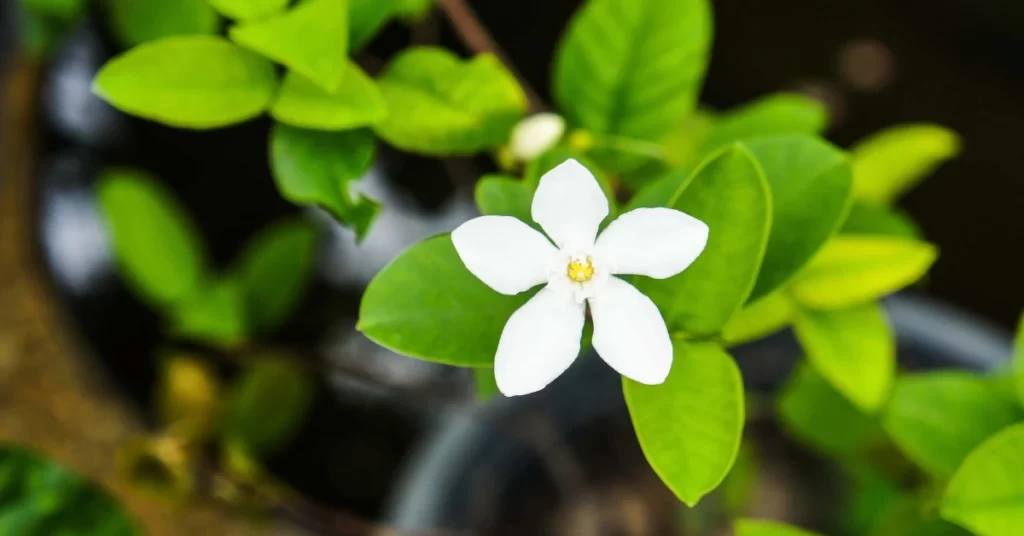
Indigenous to the higher altitudes of the Himalayan mountains, the Jai Jui thrives in its native warm, humid subtropical climate. It grows best at elevations between 3,000 to 8,000 feet where temperatures rarely freeze. The plant inhabits forests and woodlands, climbing up the trunks of trees. Jai Jui also grows well along streams and riverbanks supported by rocks and shrubs. It prefers filtered sunlight such as that under a light tree canopy.
Physical Characteristics
A climbing evergreen vine, Jai Jui plants have long, flexible stems and branches. The leaves are opposite, simple, smooth, shiny, and oval ranging between one to three inches long. Leaf color is dark green on the top with a paler green underside. The vines produce masses of fragrant white pinwheel shaped flowers about an inch in diameter. Flowering occurs from mid-summer into fall in warm regions. The fruit of the Jai Jui is a small black berry which follows the flowers. Plants will reach ten to fifteen feet in ideal conditions.
Types of Jasmine Flowers
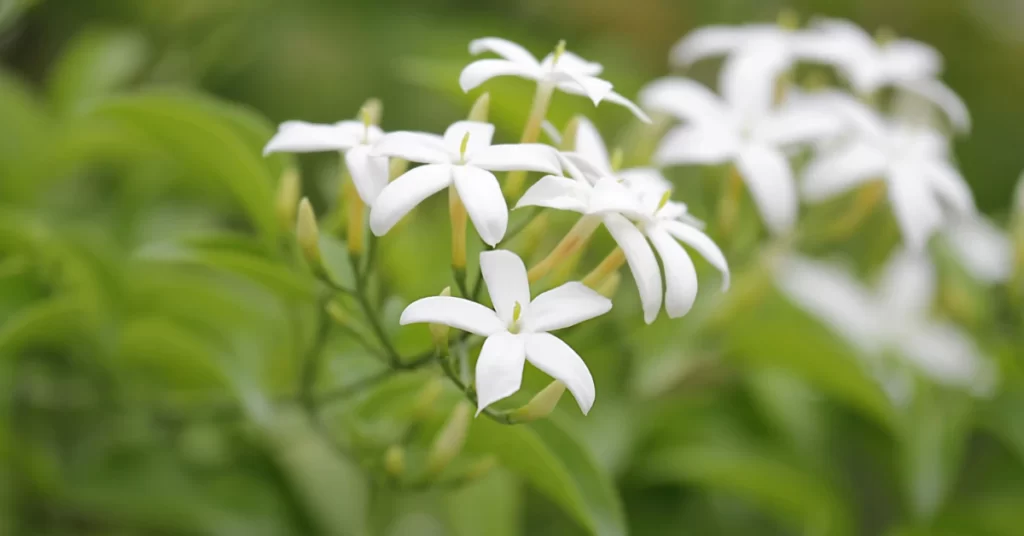
Jasmine refers to shrubs and vines from the genus Jasminum, many of which produce extremely fragrant flowers. There are over 200 species of jasmine originating from various parts of the world with a diverse array of plant forms. Here is an overview of some of the major types of jasmine flowers cultivated for their beautiful blooms and heady scent.
Common Jasmine
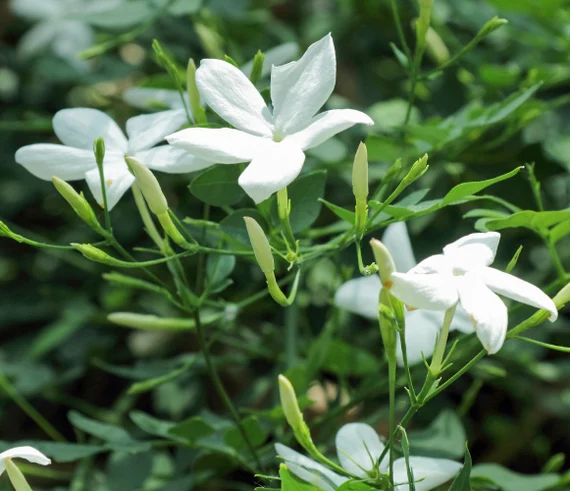
The common jasmine (Jasminum officinale) is a vining plant best known for its pure white flowers that bloom from midsummer through fall. It possesses an extremely sweet, rich floral fragrance that intensifies at night. The common jasmine grows best in warm climates but also thrives as a houseplant. Varieties like the Grandiflorum jasmine produce loose informal flowers while the Florence jasmine bears clustered blooms.
Spanish Jasmine
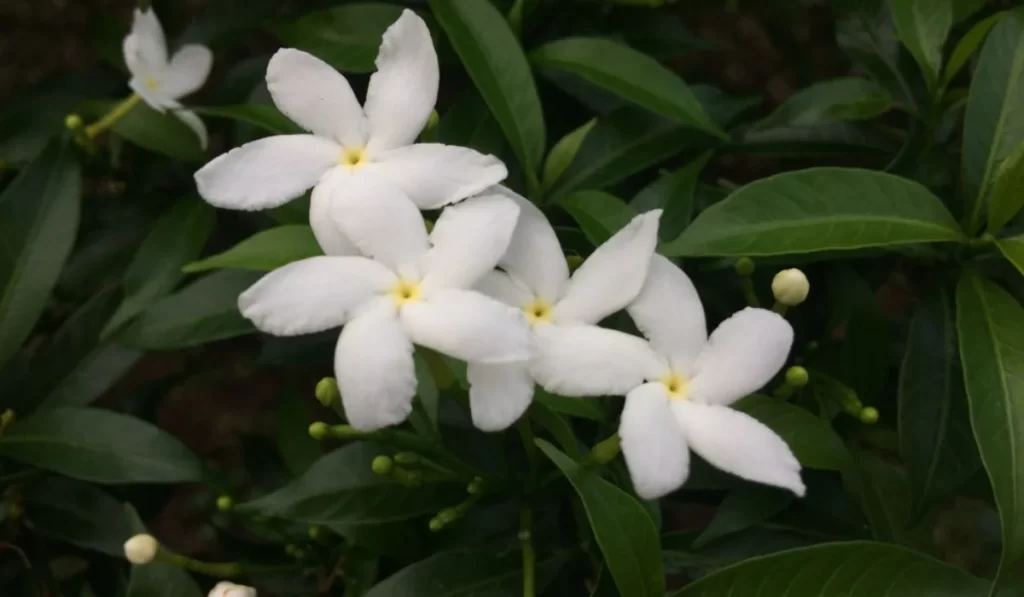
Spanish jasmine (Jasminum grandiflorum) is an evergreen vine with bright green oval leaves and abundantly produced snowy-white flowers about two inches wide with a delicate, fresh jasmine scent. The vines can reach 20 feet high when supported and do well indoors and outdoors in warm climates. This fast-growing, low-maintenance plant flowers nearly year-round where winters stay mild.
Arabian Jasmine
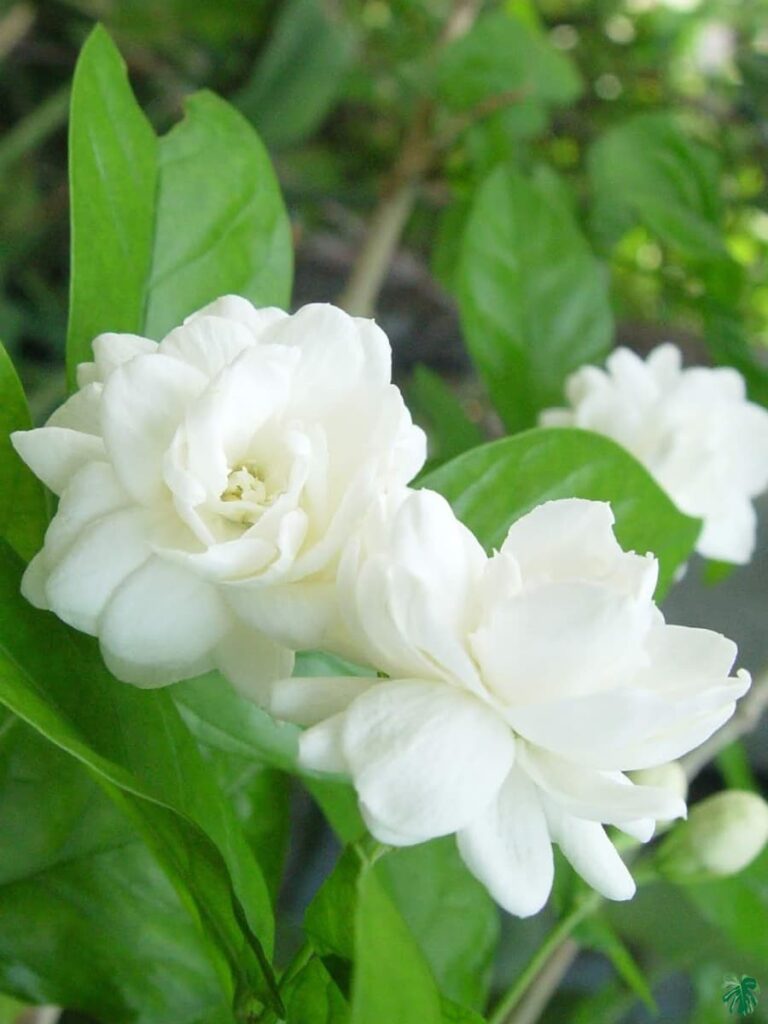
Arabian jasmine or Jasminum sambac is a beloved fragrance in parts of southeast Asia where it is native. The shiny green leaves have five to nine leaflets and clusters of petite, creamy white flowers with a sweet, musky scent reminiscent of honey. It blooms spring through fall in warm regions and nearly year-round as a houseplant. The compact Arabian jasmine thrives in containers.
Primrose Jasmine
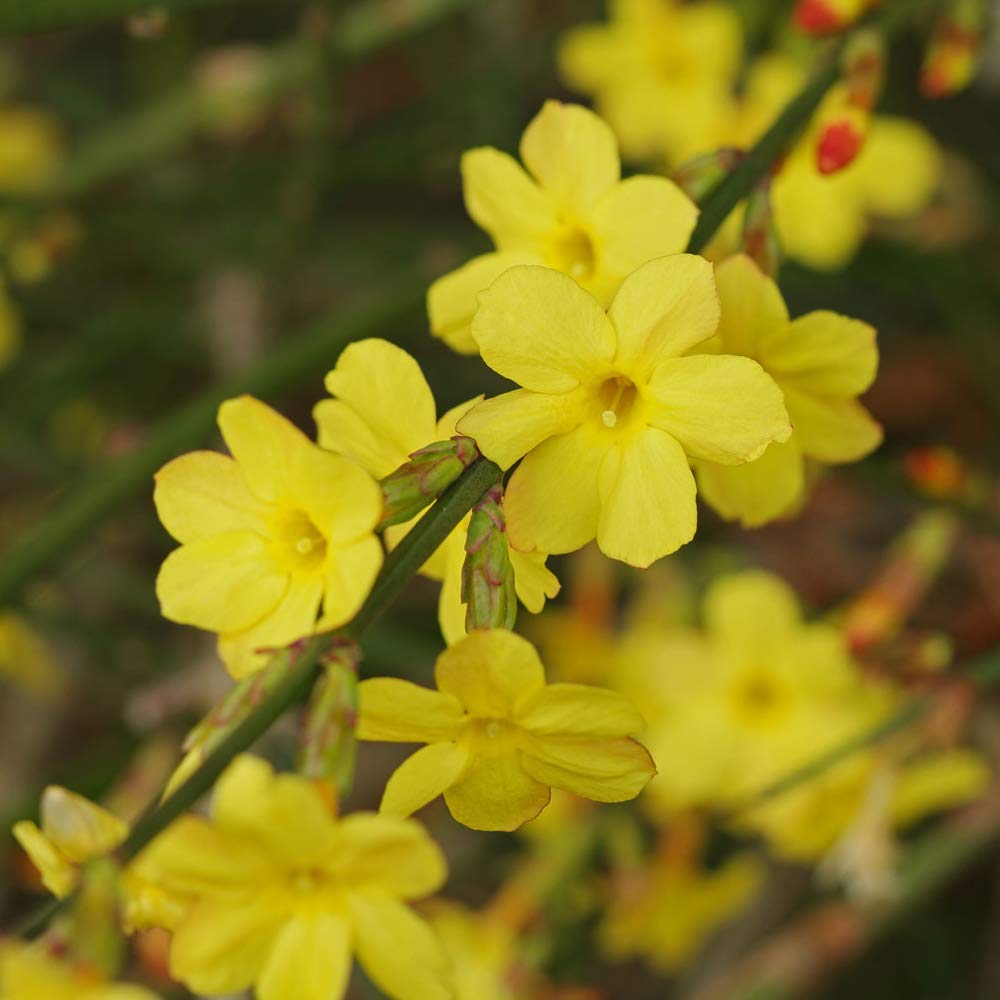
The Chinese primrose jasmine (Jasminum primulinum) shows off its bright yellow blooms in late winter and early spring, unlike most other jasmines. Slender growing vines produce abundant flowers with a fresh lemon scent. The wiry vines with pointed oval leaves can reach 10 feet but keep dense form and bloom well even when kept trimmed. Grow Chinese primrose jasmine against walls and fences or indoors near sunny windows.
Angel Wing Jasmine

Angel wing jasmine is treasured for huge white summer blooms and shiny, lyrically curved evergreen leaves resembling wings. Scientifically known as Jasminum nitidum, this vining shrub grows 15 feet high when supported. Flowers can measure up to 5 inches across, emitting heavenly sweet scent with hints of citrus and berries. It thrives in subtropical areas as a low-maintenance landscape plant and also grows beautifully in containers.
Jasmine flowers add wonderful fragrance and visual appeal to gardens, containers, and indoors. With diverse forms from dainty vines to large spreading shrubs, these elegant, sweetly scented blossoms allow enjoying intoxicating floral perfumes in various settings.
Growing Conditions for Jai Jui Flower
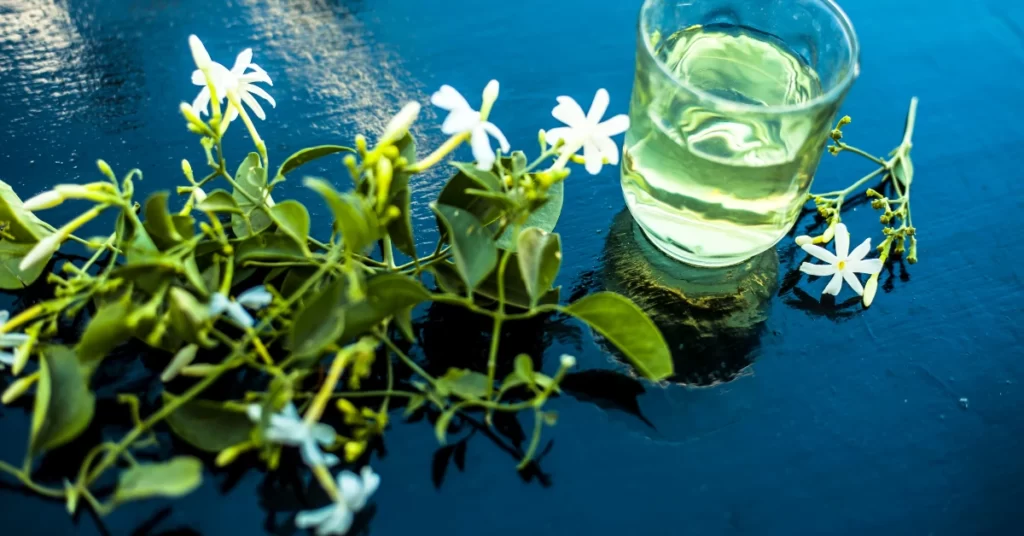
Jasmine auriculatum thrives in warmth but needs periods of cooler temperatures to successfully flower and fruit. Providing the right climate and environment will allow Jai Jui vines to flourish. This plant grows best outdoors except in the coldest zones where it should be grown in containers and overwintered indoors.
Sunlight Needs
The Jai Jui flower flourishes in well-lit locations receiving full sun to partial shade. About six hours of direct sunlight plus a few hours of dappled light is ideal. More shade will result in sparse flowering. This plant loves sunlight but requires a little protection from intense afternoon heat in the warmest zones.
Soil Requirements
Rich, fertile, and well-draining soil with plenty of organic matter provides the best conditions for jasmine auriculatum. The ideal pH range is slightly acidic between 6.0 to 6.5. Amend native soils with compost or aged manure before planting to improve moisture retention and nutrients. If growing in pots, use a quality potting mix formulated for flowering plants.
Watering Needs
Keep the soil consistently moist but not saturated for best growth and flowering. Established plants need about one to two inches of water per week depending on climate conditions like humidity, temperature, and rainfall. Water at the base avoiding wet foliage which can promote diseases. Reduce watering frequency in winter months allowing the top few inches of soil to partially dry out between deep soakings.
Temperature and Humidity
Jasmine auriculatum thrives with summer high temperatures around 80-90°F and cooler 60-70°F temperatures in winter. Outdoor plants should be protected or moved indoors if temperatures threaten to dip much below 30°F. Humidity levels of 65-80% suit the jai jui flower best. Increased humidity can be provided with pebble trays or a nearby water feature. Grow indoors in cool climates providing warmth and humidity.
How to Plant Jai Jui Flower

Getting this perfumed beauty off to the right start will let its trailing vines shine. Follow these key steps when adding jasmine auriculatum plants to your garden.
Obtaining a Start
Purchase jasmine auriculatum starter plants from a reputable nursery, choosing healthy young specimens showing vigor with no signs of disease or pests. You may also start plants from cuttings taken from an existing vigorous, healthy plant. Take cuttings that are semi-hardwood about six inches long. Remove all but two sets of leaves then root the cuttings in moist potting mix. Keep protected and shaded until well rooted then transplant.
Preparing a Planting Area
Select a sheltered, well-lit garden spot protected from strong winds. Jasmines grow well against sunny walls and fences. Ensure the soil is fertile loam amended with compost and has excellent drainage. Dig a hole or planting bed at least two times larger across and just as deep as the pot or root ball of your starter jasmine plant. Mix compost thoroughly into the soil removed from planting holes. Tamp down firmly around transplants and water in well right after planting.
Transplanting Procedure
Carefully remove potted jasmine auriculatum plants from containers without disturbing roots. Tease apart any tightly wound roots. Set the plant in prepped holes or beds positioning so the top of root balls sit one inch higher than surrounding soil. A trellis, arbor, or wires should be in place for vines to begin climbing immediately after planting. Backfill holes with amended soil and tamp down gently but firmly leaving no air pockets. Water transplants thoroughly at base. Apply mulch around plants taking care to keep it a few inches away from stems.
Caring for a Jai Jui Flower Plant

Provide attentive, consistent care and the entrancing jasmine auriculatum will reward efforts with vigorous lush foliage and abundant perfumed blooms. Monitor plants and address issues promptly to keep them thriving season after season.
Fertilization
Fertilize jasmine auriculatum monthly during the active growing season using a water soluble flowering plant food mixed at half strength. This keeps vines growing vigorously and productive without encouraging excessive tender new growth that may not harden off properly before winter chill sets in. Cease feeding about a month before the average first fall frost date in your region.
Pruning
Prune once each year before new growth begins in spring. Remove dead or damaged stems back to healthy wood. Prune out crossing stems and cut overly long vines back by one quarter to one third their length. This encourages branching, keeps growth manageable, and maximizes flowering. Pruning too frequently or heavily delays flowering. Disinfect pruning equipment between cuts to prevent disease spread.
Training and Support
Provide sturdy support structures from time of planting on which jai jui vines can climb. Install mesh panels, trellises, wires, or other climbing aids on fences, walls, pergolas, or posts. Secure main vines loosely in place with plant ties or clips as needed while side shoots and tendrils attach themselves. Check periodically and loosen ties to prevent constriction as plants increase in girth, retie or reattach as necessary.
Protecting in Winter
Jai jui flower vines grown outdoors need some protection in zones 8 and colder to survive winters. Carefully remove vines from supports and lay on ground before first frost. Cover with a thick insulating blanket of leaves, straw, or other organic mulch once dormant after several frosts. Spray with an antitranspirant to conserve moisture then wrap plants with burlap. Alternatively, grow in large pots and move containers to an unheated garage or porch for winter. Check soil moisture monthly and water sparingly if needed. Replace insulation after hard freezes. Prune back before new spring growth emerges then return outside once danger of frost has passed. Indoor plants should continue receiving bright light and slightly reduced winter watering.
Troubleshooting Problems

Monitor jasmine auriculatum vines closely for any signs of ailments and address issues promptly to restore plant health. Common problems include lack of blooms, fungal diseases, and root rot. Provide appropriate care and culture to prevent many issues.
Lack of Flowers
Insufficient sunlight, overly fertile soil, over-pruning, cool temperatures, or drought stress can prevent flowering. Move plants if necessary to increase light levels or reduce nitrogen fertilizers. Allow vines to grow undisturbed by pruning and train new growth to supports. Avoid letting soil dry out completely. Protect outdoor plants from cold under insulating mulches in winter. Indoor specimens should receive a winter cooling period of about 6 weeks with temperatures around 55°F to set buds properly.
Leaf Spot
Fungal leaf spot diseases sometimes develop on jasmine foliage, spreading rapidly in warm, humid conditions. Promote good air circulation around plants. Remove and dispose of infected foliage promptly. Apply neem oil spray or sulfur powder when leaf spot first appears and repeat as needed. Space plants adequately and avoid overhead watering of leaves to limit spread of infection.
Root Rot
Overwatering combined with poor drainage can lead to root rot issues. Allow soil to partially dry 2-3 inches deep between waterings. Mix compost into garden beds before planting to improve drainage. Grow potted plants only in containers with bottom drainage holes using a well-aerated commercial potting medium. Apply beneficial fungi and avoid excess fertilization which can aggravate root problems. Remove dead or severely infected roots when repotting. Discard severely affected plants to prevent disease spread.
Enjoying the Jai Jui Flower

The irresistible jasmine auriculatum offers gardeners beautiful visual interest and seductively sweet fragrance to savor. Enjoy these versatile vines as ornamentals, for their flavor and scent properties, or even in homemade skin care products.
Fragrance
Fully open, mature jai jui blossoms fill surrounding air with their powerfully sweet but delicate fragrance on warm, humid summer nights. Scent is most intense between dusk and dawn. Grow vines on an arbor or trellis near seating areas so the perfume can best be appreciated. Smaller plants grow well in containers on decks and patios placing them near walkways and entries to welcome guests. The essential oil extracted from these flowers is a prized component of fine perfumes.
Culinary Uses
All parts of the plant are edible including leaves, buds, and flowers which lend their perfumed flavor sparingly to beverages or desserts like ice creams and jellies. Use individual petals or small whole flowers to delicately garnish fruit salads, starters, and drinks timing it so the fragrance is at its peak when served. A few flowers or leaves can be infused in hot water for fragrant floral tea. Extracts and essential oils are used commercially as food flavorings.
Essential Oil
The precious attar or essential oil distilled from jasmine auriculatum’s small white flowers has an intense, tenacious sweet musky scent prized in high-end perfumes and fragrances. Through labor-intensive methods, about one pound of absolute oil requires approximately 8,000 pounds of harvested flowers! A few drops add lasting body and backbone to fine perfume compositions along with more volatile floral extracts. The oil’s gentle astringent qualities also make it useful in skin care products like creams or lotions.
With its intoxicating fragrance and starry white blooms, the Jai Jui flower is a jewel of a climber guaranteed to elevate gardens and delight the senses. Give this perfumed beauty the warm, dappled sunlight, rich organic soil, and moisture it requires and enjoy plentiful cascades of flowers. Train vines on supports near seating areas then relax and indulge in the jasmine scented air on a balmy summer evening.
Conclusion
With sweetly floral perfumed white blooms opening as night falls, jasmine auriculatum truly earns its common name “queen of the night.” These evergreen flowering vines flourish with proper care providing beautiful visual interest and seductively intense fragrance. Give jasmine plants warmth, filtered sunlight, rich organic soil, ample humidity, and even moisture to keep vines healthy and productive. Train flexible stems onto supports near seating areas or entries so the intoxicating aromas can best be enjoyed on balmy evenings. Cultivate the precious Jai Jui flower to elevate your garden with billowing greenery and masses of exquisitely scented blossoms.
FAQs
Q: How fast does Jai Jui flower grow?
A: Jasmine auriculatum vines can grow over 10 feet long in a single season under ideal warm, humid conditions. Expect 6 to 8 feet of growth per year on average with proper culture.
Q: Does Jai Jui flower bloom all year?
A: No, jasmine auriculatum blooms during summer and fall only, primarily from midsummer extending into late fall until frost. Flowers will not form on vines growing indoors over winter.
Q: What is the best way to propagate Jai Jui plants?
A: These plants root fairly easily from cuttings taken from healthy mother plants. Semi-hardwood summer cuttings dipped in rooting hormone then started in moist potting soil have the best success rate.
Q: How cold hardy is jasmine auriculatum?
A: Jai jui flower plants can withstand brief light frosts but sustained freezing temperatures below 25° F will kill unprotected vines. Plants grown outdoors in zones 8 and colder need heavy winter mulching or move pots to protected areas.
Q: Why are some of my Jai Jui flower buds falling off before they open?
A: Usually caused by cool temperatures or excessive drought stress, flower bud drop can be prevented by providing warm conditions (above 60 F at night) and consistently moist, fertile soil to support blossom development.
